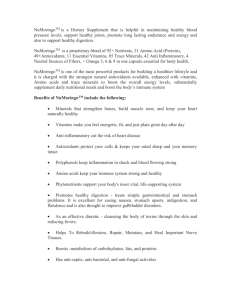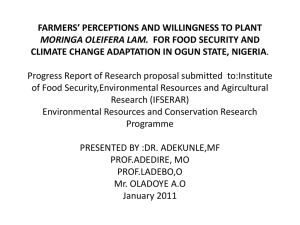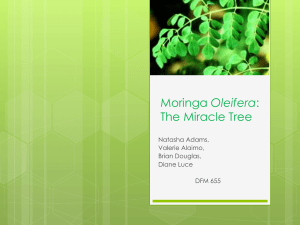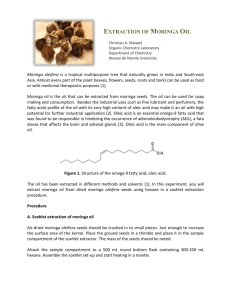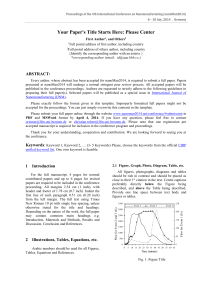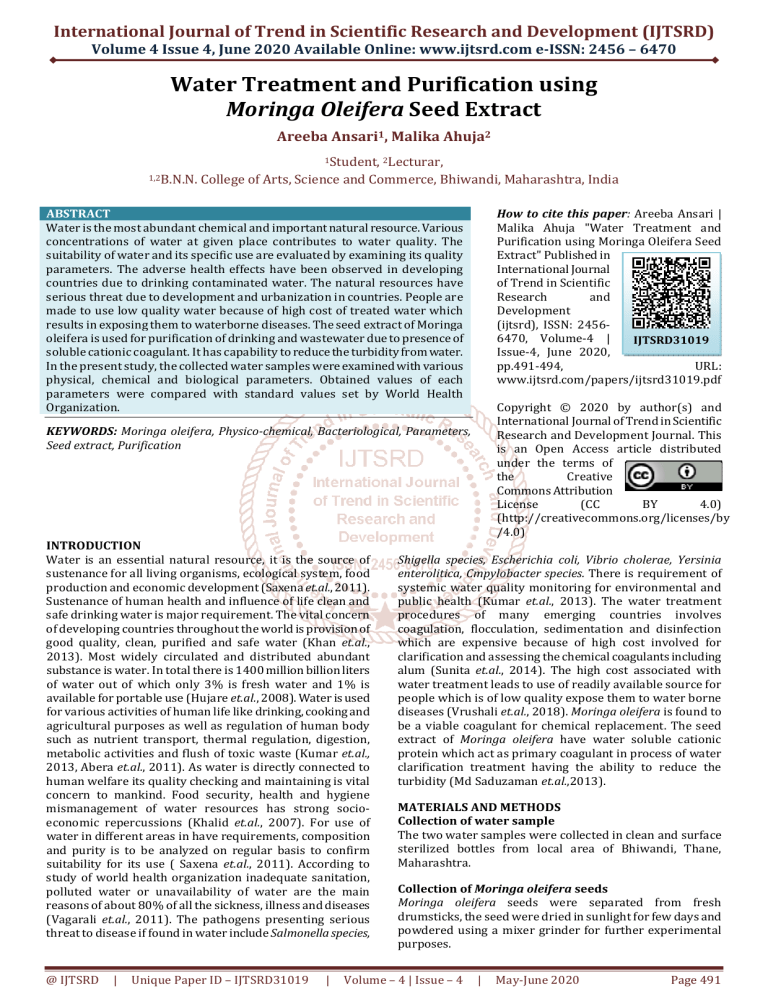
International Journal of Trend in Scientific Research and Development (IJTSRD) Volume 4 Issue 4, June 2020 Available Online: www.ijtsrd.com e-ISSN: 2456 – 6470 Water Treatment and Purification using Moringa Oleifera Seed Extract Areeba Ansari1, Malika Ahuja2 1Student, 2Lecturar, 1,2B.N.N. College of Arts, Science and Commerce, Bhiwandi, Maharashtra, India How to cite this paper: Areeba Ansari | Malika Ahuja "Water Treatment and Purification using Moringa Oleifera Seed Extract" Published in International Journal of Trend in Scientific Research and Development (ijtsrd), ISSN: 24566470, Volume-4 | IJTSRD31019 Issue-4, June 2020, pp.491-494, URL: www.ijtsrd.com/papers/ijtsrd31019.pdf ABSTRACT Water is the most abundant chemical and important natural resource. Various concentrations of water at given place contributes to water quality. The suitability of water and its specific use are evaluated by examining its quality parameters. The adverse health effects have been observed in developing countries due to drinking contaminated water. The natural resources have serious threat due to development and urbanization in countries. People are made to use low quality water because of high cost of treated water which results in exposing them to waterborne diseases. The seed extract of Moringa oleifera is used for purification of drinking and wastewater due to presence of soluble cationic coagulant. It has capability to reduce the turbidity from water. In the present study, the collected water samples were examined with various physical, chemical and biological parameters. Obtained values of each parameters were compared with standard values set by World Health Organization. Copyright © 2020 by author(s) and International Journal of Trend in Scientific Research and Development Journal. This is an Open Access article distributed under the terms of the Creative Commons Attribution License (CC BY 4.0) (http://creativecommons.org/licenses/by /4.0) KEYWORDS: Moringa oleifera, Physico-chemical, Bacteriological, Parameters, Seed extract, Purification INTRODUCTION Water is an essential natural resource, it is the source of sustenance for all living organisms, ecological system, food production and economic development (Saxena et.al., 2011). Sustenance of human health and influence of life clean and safe drinking water is major requirement. The vital concern of developing countries throughout the world is provision of good quality, clean, purified and safe water (Khan et.al., 2013). Most widely circulated and distributed abundant substance is water. In total there is 1400 million billion liters of water out of which only 3% is fresh water and 1% is available for portable use (Hujare et.al., 2008). Water is used for various activities of human life like drinking, cooking and agricultural purposes as well as regulation of human body such as nutrient transport, thermal regulation, digestion, metabolic activities and flush of toxic waste (Kumar et.al., 2013, Abera et.al., 2011). As water is directly connected to human welfare its quality checking and maintaining is vital concern to mankind. Food security, health and hygiene mismanagement of water resources has strong socioeconomic repercussions (Khalid et.al., 2007). For use of water in different areas in have requirements, composition and purity is to be analyzed on regular basis to confirm suitability for its use ( Saxena et.al., 2011). According to study of world health organization inadequate sanitation, polluted water or unavailability of water are the main reasons of about 80% of all the sickness, illness and diseases (Vagarali et.al., 2011). The pathogens presenting serious threat to disease if found in water include Salmonella species, @ IJTSRD | Unique Paper ID – IJTSRD31019 | Shigella species, Escherichia coli, Vibrio cholerae, Yersinia enterolitica, Cmpylobacter species. There is requirement of systemic water quality monitoring for environmental and public health (Kumar et.al., 2013). The water treatment procedures of many emerging countries involves coagulation, flocculation, sedimentation and disinfection which are expensive because of high cost involved for clarification and assessing the chemical coagulants including alum (Sunita et.al., 2014). The high cost associated with water treatment leads to use of readily available source for people which is of low quality expose them to water borne diseases (Vrushali et.al., 2018). Moringa oleifera is found to be a viable coagulant for chemical replacement. The seed extract of Moringa oleifera have water soluble cationic protein which act as primary coagulant in process of water clarification treatment having the ability to reduce the turbidity (Md Saduzaman et.al.,2013). MATERIALS AND METHODS Collection of water sample The two water samples were collected in clean and surface sterilized bottles from local area of Bhiwandi, Thane, Maharashtra. Collection of Moringa oleifera seeds Moringa oleifera seeds were separated from fresh drumsticks, the seed were dried in sunlight for few days and powdered using a mixer grinder for further experimental purposes. Volume – 4 | Issue – 4 | May-June 2020 Page 491 International Journal of Trend in Scientific Research and Development (IJTSRD) @ www.ijtsrd.com eISSN: 2456-6470 Estimation of Alkalinity The alkalinity of water sample is its quantitative capacity to neutralize a strong acid to a designated pH caused by HCO3 and OH- ions in water. Before titration process standardization of HCl was carried and end point was notes from yellow to orange colour (x cm3). The first alkalinity titration is phenolphthalein alkalinity which is carried using 50cm3 water sample with 0.1N Na2S2O3 solution and 1%phenolphthaleim as indicator titrated against standard HCl solution. End point is determined when pink color just disappear or fade(y cm3). Alkalinity results were reported in terms of mg of CaCO3. Estimation of Chemical Oxygen Demand (COD) Organic substances present in water sample are oxidized by K2Cr2O7 in acidic medium. The sample was heated in presence of Ag2SO4 as catalyst, HgSO4 was used for removal of chloride interference. The excess of K2Cr2O7 was titrated back against ferrous alum solution. Amount of oxidisable organic matter measured as oxygen equivalent is proportional to K2Cr2O7 consumed. In two round bottom flasks few porcelain pieces, 1g 20% HgCl2, 5cm3 K2Cr2O7 conc.H2SO4, 50 cm3 of 0.025N K2Cr2O7 and 5 cm3 of 1% Ag2SO4 solutions was added. In last add 25 cm3 of distilled and sample waters in respective tubes and keep for refluxing on boiling water bath for 90 minutes. Now, titrate the sample after cooling with 0.025M ferrous alum using indicator 0.025M ferroin. End point will be from green to red colour. This method determined the COD value of 50 mg/dm3 or more. Estimation of Biological Oxygen Demand (BOD) Biological oxygen demand is the amount of dissolved oxygen needed by aerobic biological organism to break down organic matter present in given water sample at certain temperature over a specific time period. Samples were labelled as sample1 (Day 1&5) and sample2 (Day 1&5). To both the samples 2.0 ml of MnSO4 and 2.0ml of alkali iodide azide were added. Precipitate of MnSO4 was formed which was dissolved by adding 2.0ml of H2SO4. It was titrated against sodium thiosulphate using starch as indicator and readings were recorded in terms of 0.0125N sodium thiosulphate for titration. The BOD value was expressed in milligrams of oxygen consumed per liter of sample on both day 1 and day 5 for both blank and test respectively. Calculation: Amount of Na2S2O3 = Sample 1– Sample 2 BOD in mg/L = A*Normality of Na2S2O3*8*1000*dilution factor / Amount of sample Isolation and Identification of Bacteria Selective and differential media was prepared as per standard protocol and after sterilization agar plates were prepared under aseptic conditions. Different water samples collected; were streaked on different media. The plates were incubated at 37⁰C for 24 hours to observe bacterial growth. Biochemical tests were done to identify the microorganisms. Most Probable Number (MPN) Most probable number analysis is a statistical method based on the random dispersion of microorganism per volume in a given sample. For presumptive test 10ml water sample was inoculated in three double strength Lauryl Tryptose Broth (LTB) tubes. In these tubes, 0.1ml and 1ml of water sample was added in three single strength LTB tubes. The tubes @ IJTSRD | Unique Paper ID – IJTSRD31019 | were incubated at 37⁰C for 48 hours for gas production observation. Tubes showing positive presumptive test (gas production) were inoculated one loopful in sterile BGLB tubes and incubate at 37⁰C for 48 hours and check for gas production in BLGB tubes constitutes positive confirmed test. Determination of Initial Number of Organisms Present in Water Sample Firstly, 1.0ml of both water samples were poured in sterile petri plates and then at about 45⁰C R2A agar media was poured, as agar solidified the plates were kept for incubation at 37⁰C for 5 days. Regularly observation was taken and results were noted. Addition of Moringa oleifera seed powder in water samples The water samples were treated in the addition of Moringa oleifera seed powder at different concentrations of 0.2% to 2.4% gm of seed powder. This added water sample were kept into purification for 10 days. Determination of Final Number of Organisms Present in Water Sample The treated and control water sample were examined on the basis of appearance, taste, pH, odour and microbial evaluation, total bacterial count were taken for each treated sample and control by pour plate method. Both the samples were filtered with whatsman filter paper and 1ml of treated sample was added on R2A agar media plate and incubated for 24 hours. The evaluation of bacterial count was observe and compared to untreated water sample. RESULTS AND DISCUSSION Collection of Water Samples Water samples from lake and tap were collected in sterile plastic bottles to avoid additional contamination due to nonsterile bottles. The bottles were transported immediately to laboratory with appropriate care and stored at 4⁰C till further processing. Collection of Seed Powder Moringa oleifera seeds were collected from fresh drumstick plant, dried on sunlight for few days and then powdered using grinder for further test. Determination of pH in water samples Digital pH meter is used to check the hydrogen ion concentration in both water samples. The readings were taken after 1 minute constant value (Kanase et.al., 2016). The results are observed as given below in table no.1 Table no.1: Determination of pH in water samples Water Samples pH Sample 1 7.2 Sample 2 7.2 Drinking water with a pH between 6.5 and 8.5 is generally considered satisfactory. The hydrogen ion (pH) in both the samples is 7.2 which is within the safe limit set by WHO standard and hence will not cause any harmful effect. Determination of Alkalinity in water samples The water samples were checked for alkalinity, measured by content of hydroxide and carbonate ion present in samples. Volume – 4 | Issue – 4 | May-June 2020 Page 492 International Journal of Trend in Scientific Research and Development (IJTSRD) @ www.ijtsrd.com eISSN: 2456-6470 It is titrated with standard HCl, result are displayed in table no.2 Table no.2: Determination of alkalinity in water samples Water Samples Alkalinity (mg/L) Sample 1 350 Sample 2 330 Acid neutralizing capacity is alkalinity of water due to presence of carbonates and bicarbonates. The range set by WHO is 500mg/L (Kanase et.al., 2016). Both the samples showed alkalinity in range of 400mg/L. Determination of Chemical Oxygen Demand in water samples For both the samples chemical oxygen demand was determined by using dichromate refluction method. The results are as displayed in table no.3 Table no.3: Determination of chemical oxygen demand Water Samples COD (ppm) Sample 1 200 Sample 2 719 Oxygen is important component as it is required for degradation of organic matter hence COD is important parameter. Both the samples showed a large variation in chemical oxygen demand. Determination of Biological Oxygen Demand in water samples Biological oxygen demand of both the samples were tested, the maximum value as per WHO standard is 2.0mg/L for drinking purpose. The results are shown in table no.4 Table no.4: Determination of biological oxygen demand Water Day 1 Day 5 Results Samples (mg/L) (mg/L) (mg/L) Sample 1 13.5 2.9 1160 Sample 2 15.0 3.2 1180 The tests showed wide range obtained under BOD test with minimum value 2.9mg/L observed. No similar results were obtained. Sample1 and sample2 showed BOD as 1160mg/L and 1180ma/L respectively. Water Samples Sample1 Sample2 Determination of Most Probable Number (MPN) Method Determination of most probable number for both the water samples was done using multiple tube method. The results are given in table no.5 Table no.5: Determination of most probable number Water MPN Index 10 ml 1.0ml 0.1ml Samples per 100ml Sample 1 0 1 0 2 Sample 2 1 1 0 4 According to WHO standard for drinking water quality there should be < 1 MPN/100ml of total coliforms and no Escherichia coli in 1ml of water (Olowe et.al., 2016) reported MPN index in the range of 2-60 MPN/100ml. Both the water samples used for this study showed MPN index 2 to 4 MPN/100ml. Determination of Initial Number of Organisms in water samples Pour plate method was used to determine initial count of organisms in untreated water sample, they were observed and found that lake water (sample1) contain large number of organism as compare to tap water (sample2). The results are as shown in table no.6 Table no.6: Determination of initial number of organisms Water Physical Number of Source appearance organisms (cfu/ml) Sample 1 High yellow 1800 Sample 2 Yellow 1500 Isolation and Identification of Microorganisms Microbiological and biochemical investigations were carried out of various water sample. Olowe et.al., 2016, Vagarali et.al., 2011, Abera et.al., 2011 reported presence of Escherichia coli in the range of 10% to 17.3%. The present study of both water samples confirmed presence of Escherichia coli. Determination of Final Number of Organisms in water samples The water sample was treated with Moringa oleifera seed extract thus the treated sample was checked for reduction in total bacterial count, it was observed that highest bacterial reduction count was on 2.4% of plant extract by pour plate method. The results are displayed in table no.7 Table no.7: Determination of final number of organisms Physical appearance pH 0.2% 0.6% 1.0% 2.2% 2.4% Number of organisms (cfu/ml) Clear 7.0 1600 300 90 50 20 Clear 7.0 1100 900 400 50 10 Control 3800 2500 Reduction in total bacterial count was observed that 2.4%. Similar results with reduction in bacterial count were observed by Yongabi, et.al., 2011. CONCLUSION Water plays important role for sustenance of industries, agriculture and human existence. The healthy water ecosystem is depended on physico-chemical and bacteriological characteristics. It is observed that water gets polluted significantly due to human activities, seed of Moringa oleifera were used for water purification. Alkalinity @ IJTSRD | Unique Paper ID – IJTSRD31019 | and pH of both the samples were as per WHO standard, the COD of sample 2 was not found to permissible limit where as BOD of both the samples had unacceptable values. MPN index indicates presence of greater number of bacteria and was positive for Escherichia coli. The turbidity and bacterial count was reduced by using Moringa oleifera seed extract, Volume – 4 | Issue – 4 | May-June 2020 Page 493 International Journal of Trend in Scientific Research and Development (IJTSRD) @ www.ijtsrd.com eISSN: 2456-6470 2.4% of powder has ability to reduce the impurities from water.The study can be used to determine fungal, algal, viral count present in water samples. Moringa oleifera is a natural coagulant produces biodegradable environment friendly sludge as compared to chemical coagulant. Properties of Moringa oleifera like adsorbent, coagulant, dewatering and desalting agent can be checked and used for removal of heavy metals from water. ACKNOWLEDGMENT I would like to thank Miss Malika Ahuja for helping me in doing research as well as for giving her major contribution in writing and proof reading the research article. REFERENCES [1] Abera S, Zenyinudin A, Kebede B, Deribew A, Ali S, Zemene E (2011); Bacteriological analysis of drinking water sources. Afri.Micro.Res.2011:5(18):2638-2641. [2] Chaubey Soni and Mohan Kumar Patil (2015). “Application of Artificial Neural Network in Assessing Water Quality: A Case Study”, International Journal of Current Research Vol.7, Issue01, pp.11403-11407, India. [3] Dhanaji Kanase G, Shagufta Shaikh A, Pramod Jagadale N (2016); Physico-Chemical analysis of drinking water samples of different places in Kadegaon Tahsil, Maharashtra (India); Pelagia Research Library; 7(6):4144. [4] Hujare, M. S. (2008): Seasonal variation of physicochemical parameters in the perennial tank of Talsande, Maharashtra. Ecotoxical. Environ. Monitor. 18(3):233242 [5] Khalid Anwar, Amir Haider Malik, Amir Waseem, Shazmeen Zahra and Ghulam Murtuza (2011); Qualitative and quantitative analysis of drinking water of different localities in Abbottabad district, Pakistan; Internation journal of the physical science; Vol 6(33).pp 7480-7489. [6] Khan Naeem, Sayef Tasleem Husain, Asif Khan, Kyong Su Kim (2013); Physico-chemical investigation of drinking water sources from Tehsil Lachi, Kohat; American journal of research communication;Vol1(5): 170-190. [7] Kumar Deepesh, Shurutikirti Malik, Mollu Madan, Anita Pandey, Ashish K, Asthana (2013); Bacteriological @ IJTSRD | Unique Paper ID – IJTSRD31019 | analysis of water by MPN method in a tertiary care hospital and adjoining area western up, India. IOSR Journal of Environmental science toxicology and food technology 4(14). [8] Md saduzzaman, S. Sharmila, Jayanthi rebebeca L.; Domestic waste water treatment using leaf extract of Moringa oleifera; Research journal of pharmaceutical, biological and chemical; 4(2): 833-839 [9] Mnjula A, Shamkar G, Karadesai Preeti, Sharada Metagud (2011);Bacteriological analysis of water, Journal of Bioscience and Technology 2(1):220-222. [10] Olowe Busayo Mutiat, Jacob O. Oluyege and Oladiran Famurewa (2016); Prevalance of water borne disease and microbial assessment of drinking water qualoty in Ado-Ekiti and its environs; British microbiology research journal; 12(2): 1-13. [11] Saxena Nidhi, S.N.Misraand R.N.Shukla (2011); Physico-chemical and Bacteriological analysis of water quality under different environmental condition; Journal of chemistry and pharmaceutical research; 3(2):162-167. [12] Shimpi Vrushali V., Jhondle Pooja R., Gangurde Ritu B., Jadhav Tejal D., KapseVikashni Nand, Maataa Matakite, Koshy Kanayathu and Sotheeswaran Subramanium (2012);Water pirification using Moringa oleifera and other locally available seeds in Fiji for heavy metal removal; International journal of applied science and technology ;2(5): 125-129 [13] Shireen S. (2018); Water purification using Moringa oleifera (Drumstick) seed powder as a natural coagulant; Recent Advances in Engineering Science and Management ;89-83 [14] Thakur Sunita Singh, Chaubey Sonal (2014); Assessment of coagulation efficiency of Moringa oleifera and okra for treatment of turbid water; Archives of applied science and research; 6(2): 24-30. [15] Yahya Daniyan Safiya, Enemaduku Moses Abalaka and Euro E.O. (2011); The use of Moringa oleifera seed extract in water purification; IJRAP; 2(4): 1265-1271. [16] Yongabi K. A., Lewis D. M. andvHarris L. P. (2011); Application of phytodisinfectants in water purification in rural Cameroon; African journal of microbiology research; 5(6): 628-635. Volume – 4 | Issue – 4 | May-June 2020 Page 494

